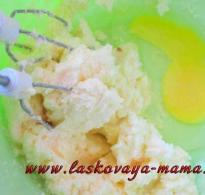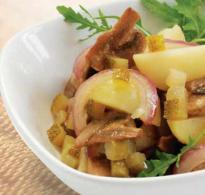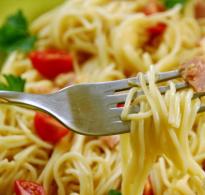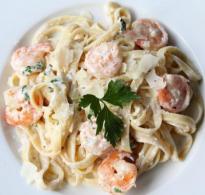False and poisonous russula: their photos and how to distinguish them from edible mushrooms? poisonous mushrooms
Have you ever seen mushroom pickers who, having collected full baskets in excitement, then simply poured them out? This happens when people are afraid of poisoning because they do not understand mushrooms. Indeed, such a danger exists, and from severe poisoning mushrooms people have died at all times. In antiquity and the Middle Ages, poisonous mushrooms were even specifically used to eliminate rivals in the struggle for power. How to distinguish edible mushrooms from inedible and poisonous? Many people believe that worms are never found in poisonous mushrooms, slugs do not eat them, and they themselves are different from good mushrooms Not pleasant smell and bright or toxic coloration. Also considered signs of toxicity are thin leg and a ring on it. Actually this is not true. Indeed, some of these signs are found in those mushrooms that cannot be eaten, but there are poisonous mushrooms with a completely pleasant smell and color, which are eaten with pleasure by both worms and some wild animals. Therefore, the only way to protect yourself is the knowledge of mushrooms. Or you should consult with an experienced person with such knowledge before cooking mushrooms.
poisonous mushrooms
Of those mushrooms that grow on our continent, about three dozen species are considered poisonous. And the most dangerous of them is the common death cap, containing the most dangerous poison - amanitotoxin, which is not destroyed by any processing. A quarter of the cap of this mushroom is enough to poison an adult. Moreover, the signs of poisoning appear very late - after 10-48 hours, when the action of the poison already leads to irreversible damage in the liver, kidneys and other organs. Helping a person in such cases is almost impossible. A pale grebe gets into the baskets of mushroom pickers when it is confused with russula or champignons.
A close relative of the toadstool is the fly agaric. Fortunately, in most cases, it gives itself away with a characteristic appearance and a sharp, unpleasant odor. Also, by smell, you can distinguish poisonous champignons from completely edible ones - they smell like medicines, a pharmacy.
Many poisonous mushrooms closely resemble their edible relatives. These are false mushrooms false chanterelles, false raincoats, thin pigs. There are also conditionally poisonous mushrooms that can be eaten only after a long heat treatment such as stitches and morel mushrooms.
Conventionally, all poisonous mushrooms can be divided into three groups according to the nature of the poisoning they cause. The most dangerous are those that contain strong poisons affecting the kidneys, liver and other important internal organs- grebe, sulfur-yellow honey agaric, etc.
The second group, to which fly agarics belong, fungi of the genus Inocybe, contains poisons that act on the nerve centers. Such mushrooms, in addition to the usual signs of poisoning (nausea, vomiting, sweating), cause hallucinations and various nervous reactions - causeless laughter, crying, etc.
The third group includes mushrooms containing local poison. Incidentally, they include autumn honey agaric, which can cause serious digestive disorders if not properly or insufficiently cooked.
In addition, it is possible to get poisoned with completely edible mushrooms if, during their canning, soil particles containing botulism bacteria get into the jar. It is also not recommended to collect and eat old mushrooms and mushrooms growing near highways or industrial facilities.
If you notice signs of mushroom poisoning, you should immediately call a doctor, and wash the stomach of the victim and give a laxative.
I don’t know for sure, but I think that they can never be wormy inedible mushrooms. different kind toadstools and toadstools. Due to the toxins they contain, they are equally poisonous to humans and to all kinds of worms harmful to mushroom pickers. If moose eat fly agaric, then there's nothing to say about worms))) - 4 years ago Quite possibly I'm wrong. Never looked closely at toadstools. I'm going to go this weekend and take a look. But I think the moose is big. He looks ..... He has the poison contained in the fly agaric, which is a pellet for an elephant. He just gets a little carried away by it. And the worms are small. They just need to sniff this mushroom a little and they will be kirdyk. :о))) - 4 years ago Worms have no chance.... :о))) - 4 years ago Read here))) http://okafish.ru/grib/jadovit1.htm (especially the text near the picture ) I'm an avid mushroom picker, so I know what I'm talking about))) - 4 years ago More than once I found pale grebes, both eaten and feasting on slugs. Inside, I didn’t look at the subject of worminess :) But we don’t have chanterelles: (We don’t have a wormy tinder fungus and from the same opera - chaga. - 4 years ago Ooh, they catch a buzz from fly agarics, and especially from pale grebes)) ) - 4 years ago All. Went to the forest. This time the fly agaric did not find the metamorph, but he carefully examined all the grebes that he found. (By the way, I can send them to everyone by mail, for verification of my words). There are no worms or slugs on them. Of course, this does not mean that there are no such worms and slugs all over the world that are engaged in eating non-edible mushrooms, but I think that these do not live long. Only until his first poisonous mushroom. - 4 years ago Wolf_chat. You were not interested in the health of these slugs, well, let's say, a day after you saw them eating grebes. It is quite possible that it has significantly staggered and dropped sharply. :o))) - 4 years ago No, well, there should be traces of the feast. Bite marks, eaten sections of the fungus, and leftover ketchup. :o))) - 4 years ago :o))) Half-bitten mushrooms should also be found from time to time. :O))) As for moderation, I think that people will be interested in reading this after us. So maybe it will even increase the attractiveness of the site. Therefore, I sometimes allow myself to deviate a little from the rules. - 4 years ago green toadstools ate, and dead slugs were not noticed nearby. We caught the buzz and flew away: D - 4 years ago I didn't pick mushrooms anymore.Maybe they have become more cultured now, they don't gnaw anything at all))) Gourmets, fir-trees-sticks!))) - 4 years ago Horoshshcho. We tie. All the same, I won’t change my mind until I personally make sure :o))) of the opposite, but I can’t fight off the two of you. :o))) And here is an excellent reason for retreat. :o))) - 4 years ago
False russula usually have too bright color
An extensive family of russula belongs to the genus Russula (Russula). In fact, real poisonous russula do not exist in nature, and in addition to unambiguously edible ones, they simply occur. conditionally edible species. In the latter, the conditionality of edibility lies in the bitter taste, which, however, disappears after heat treatment. Therefore, they cannot be eaten raw or fried, but without restrictions they can be salted or pickled.
But there are several species that have a particularly caustic and burning pulp; they are classified abroad as poisonous or inedible russula. Their raw pulp causes vomiting in the taster and severe irritation of the mucous membranes of the mouth, in the worst cases, it can come to a slight disruption of the digestive tract, but this still cannot be called a real poisoning.
The following signs may alert the mushroom picker and make him refuse to take suspicious mushrooms:
- too bright coloring;
- bad smell;
- discoloration of the pulp of mushrooms when cut or boiled.
Knowing these signs, many mushroom pickers tend to classify conditionally edible russula as false, but with scientific point of view, this is not true, since false and real russulas can have similar "suspicious" qualities.
Yellow types of inedible russula

The confusion with the edibility of russula is such that mushroom pickers often classify some yellow russula as dubious. For example, the light yellow russula (R. Claroflava) has a bright yellow hat, and its original white pulp it turns gray on the cut, and it also darkens when cooked, and this is uncharacteristic for most edible russula.
Even having studied edible and inedible photo russulas, the mushroom picker is very likely to confuse them. For example, ocher russula (R. Ochroleuca) with valem (R. Foetens), since both fungi prefer moist forests. In R. Ochroleuca, the flesh also darkens a little at the break, it has no smell, but there is a very pungent taste. It differs from yellow russula in color: if in the latter it is clean and bright, then in ocher it is dirty yellow.
Valuy, although it is considered a conditionally edible mushroom, is ignored by most mushroom pickers, since its flesh becomes brown at the break, besides, it smells unpleasantly of rancid oil, and tastes burning bitter. Valui for use in food must first be soaked for a long time, then boiled in several waters, which not every housewife will decide on.
Therefore, for those who do not want to spend many hours at the stove, it is better, when collecting russula with light hats, to avoid those specimens that have no pleasant taste and smell.
Golden-yellow russula (R. Risigalina), although edible, has an inexpressive taste. It is smaller than the yellow one, and its spore powder is egg-yellow.
Green and brown russula

The green russula (R. Aerguinea) has a marsh-colored hat that is not very attractive, in some ways it even resembles a pale grebe, and its taste is as attractive as its appearance.
Purple-brown russula (R. badia). In the photo, inedible russula of this species in their youth have beautiful purple-red hats that grow up to 8-12 cm. They have an ocher spore powder, and the smell is specific, like a cigar box and a very bitter unpleasant taste.

Burning-caustic russula

If someone by all means wants to see what the poisonous russula looks like, he should look at the photo of the burning-caustic russula (R. Emetica). She has a blood-red cap measuring 5-10 cm, which becomes slippery and ocher yellow in rainy weather. The cap is convex, thinly fleshy, then becomes concavely procumbent or flat procumbent, its ribbed or smooth edge is sharp at first, then becomes blunt. Fragile flesh at a smooth white or pink leg, and at the cap under the skin is slightly reddish. The skin is slimy, detaches up to half the radius of the cap from the edges, it is bright red, but fades to light pink. Frequent plates have abundant anastomoses, and are white or slightly cream in color. The smell of the mushroom is pleasantly fruity, and the taste is very pungent. But still, this russula is only inedible, and it does not pose such a danger as the most poisonous mushroom.
Black russula
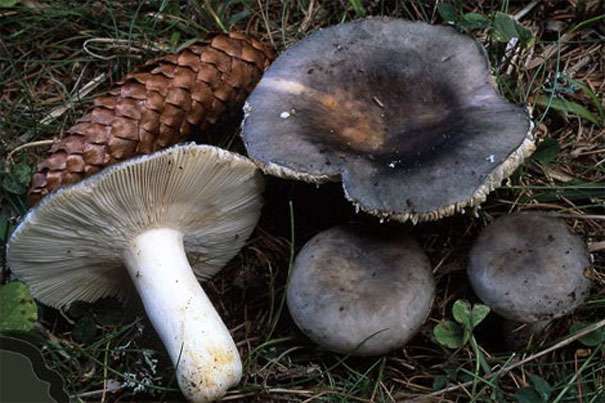
Such false russulas as black(R. Adusta), blackening(R. Nigricans), often lamellar(R. Densifolia) and other loads are the most unpresentable of their kind. These are all conditionally edible mushrooms, outwardly more reminiscent of milk mushrooms (milkers), and not russula. They have short legs, to which the plates have grown, the centers of the caps are depressed, but they do not secrete milky juice. The black podgruzdok, in addition, has bad smell mold. These mushrooms always have dirty hats, in leaves and earth, which are also painted in sooty brown or dark gray inconspicuous shades. But this is not all the differences between classic russula and podgruzdki:
- Loads belonging to the 4th category in nutritional value are used mainly for salting.
- When cut, their flesh invariably first turns pink, and then darkens further to gray or even black.
- Before salting, such mushrooms must be soaked or boiled for at least 20 minutes. But even being salted, the loads get an unpresentable dark look.
- Loaders are almost always wormy. And since it's easy food poisoning can be obtained not only as a result of improper preparation, but also due to the activity of worms, it is best not to be greedy and leave these mushrooms for the inhabitants of the forest, but to give preference to other russula, which are always enough in a good forest.
Russula blood red

Translated from Latin, this russula is blood red. (R.Sanguinea) sounds menacing - "bloody" or "bloodthirsty." The 5-11 cm caps of these mushrooms have various shades of red: raspberry, pink, carmine or scarlet, in the sun they can all fade to pale pink. Matte in dry weather, when it rains, the hat becomes shiny and slightly sticky. It has a smooth or slightly wrinkled surface. The caps of young mushrooms are hemispherical in shape, while in older ones they become slightly depressed or prostrate.
From slightly ribbed or wavy edges, the skin is removed easily, but not in the center of the cap. Although these are not false russula, photos of these Not edible mushrooms it is desirable to see: the blood-red russula has a solid bright pink (sometimes grayish) smooth leg, not exceeding 8 cm in height and having a club-shaped or cylindrical shape. The plates of the cap are frequent and narrow, cream or white, sometimes with yellowish spots. White and dense pulp has no pronounced smell, but has spicy taste. It grows on acidic and sandy soils in mixed and pine forests, sometimes in open places.
Similar russulas:
- pink-footed russula (R. Rhodopus) has a mild pleasant taste, and its hat shines even in dry weather;
- swamp russula (R. Helodes) grows exclusively in mosses, has a lighter leg;
- brown russula (R. Xerampelina) smells like raw herring and is darker colored.
Russula spicy
![]()
Many mushroom pickers are interested in the question: how to distinguish these conditionally false russula from completely edible ones? Spicy russula (R. Sardonia) has light purple, lilac or purple caps, and the center is either greenish or almost black. The caps of young mushrooms are convex, and then they become slightly depressed with smooth or slightly ribbed edges. The peel adheres to the pulp very tightly. Solid, up to 9 cm high, the leg is smooth and even, lilac or pink. The yellow plates are narrow and frequent. The yellow flesh is very pungent. The fungus grows from late summer to early October throughout the temperate zone of Eurasia, preferring sandy soils of pine forests or spruce forests.
birch russula
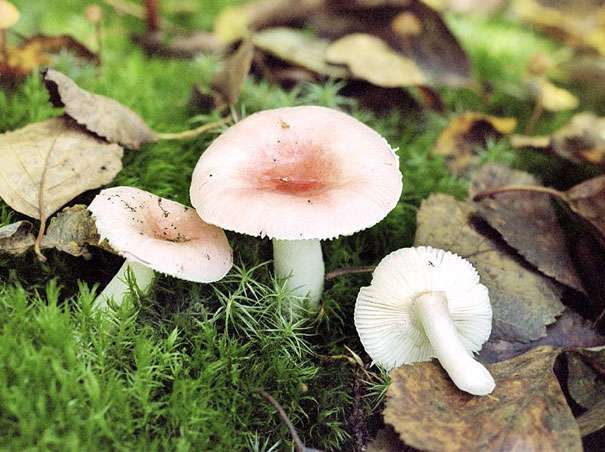
This birch russula (R. Betularum) has a small hat (up to 7 cm), acquiring colors from yellow or beige to lilac or pinkish. Young mushrooms also have hemispherical or convex caps, which eventually flatten to slightly depressed or almost flat. In the rain, the skin becomes slippery, easily separated from the pulp. White club-shaped or cylindrical legs are very brittle, in old mushrooms they become hollow inside. Frequent white plates are sometimes almost free, sometimes attached or even torn. The crisp white flesh is acrid in taste but has a pleasant fruity aroma. These russula grow near swamps or in damp areas of the forest around birches. Growth time: mid-June - end of October. In some places in Europe it is even listed in the Red Book.
Do you know how to distinguish edible russula from their inedible counterparts? On what grounds are you able to do this? Share your experience in
Our ancestors called mushrooms "forest beef" - because they helped maintain health and strength for many weeks of fasting.
NEITHER FISH NOR FOWL…
These strange organisms occupy an intermediate position between the plant and animal kingdoms. For centuries, scientists have fought over the question of what they are after all. The French botanist of the 17th century, Veillant, even believed that they were specially created by the devil in order to disrupt the harmony of nature and drive researchers to despair.
In the end, they were still classified as plants, thus legitimizing not only their place in the plant world, but also our right
feast on mushrooms fast days. However, the reckoning is rather conditional and still raises objections. Judge for yourself.Mushrooms are devoid of chlorophyll and are unable to process inorganic substances into organic, as plants do. Like animals, they form urea during metabolism and contain glycogen, a type of starch found only in animal organisms.
Mushrooms are incredibly high in protein (how much depends on the type and method of preparation). For example, in salted mushrooms it is 22% in terms of dry weight, and mushroom powder from champignons contains as much as 45% of protein!
It also brings mushrooms closer to meat a large number of extractive substances that give food a bright expressive taste. It is for this reason that, like meat, you can cook broths and gravies from them. Even a small addition of mushrooms makes any dish tastier.
Most of the proteins are in porcini mushrooms, fat is in boletus, carbohydrates are in mushrooms, vitamins A and group B are in chanterelles.
And among other things, there are a lot of mushrooms coarse fiber which is so lacking for all of us. In a word, not a product, but a dream of a nutritionist.
LOVE IN RUSSIAN
For Europeans, mushrooms are a delicacy; they cook from them fine dining without going too far into biochemistry. In the countries of the Pacific region, mushrooms are a medicine and a dietary supplement; there are more interested in their healing properties. On the American continent, the very word provokes a wary reaction - about the same as we have the equally innocent word "cannabis". Indeed, from wild mushrooms, they know and use mainly "magic" mushrooms-hallucinogens.
In Russia, mushrooms are treated in a very special way. Only in our country the mysterious phrase "mushrooms have gone" can cause excitement among both rural residents and townspeople. Only we come across eccentrics who passionately love mushrooms - and at the same time they don’t eat them at all: they just love to look for them.
Hence the differences in preferences. Mushrooms, which, in fact, feed on the whole world, we called dung beetles and never respected - for the lack of romance. The mushroom must hide from the mushroom picker in the forest and do it beautifully.
But we know and know how to cook great amount species of wild mushrooms, including bitter, burning, conditionally edible, strange-looking. Moreover, in one area, some mushrooms are considered a delicacy, while in another region they are classified as inedible and are not harvested at all.
"REAL ROUGH FEW..."
It is clear that with such traditions it is useless to dissuade our man from picking mushrooms. Although those who are seriously concerned about their health are increasingly choosing to buy white and mushrooms in the store. For the rest, there are several commandments that must be followed.
Everyone knows about the danger of poisoning with poisonous mushrooms. The most dangerous is the pale toadstool: the toxins contained in it are fatal to humans in a very small dose.
But those who collect completely edible mushrooms suffer much more often, only in the inedible phase: old, wormy, overripe ... Mushrooms deteriorate in old age, accumulating all sorts of rubbish. Hence the rule: collect only young and healthy mushrooms. If you are not completely sure of your knowledge and want to be on the safe side, boil the collected mushrooms for 15-20 minutes, drain the water and rinse them again before preparing any dishes.
It is also known that mushrooms have the ability to accumulate heavy metals. This is a general pattern: all types of food with a rich mineral composition(for example, animal liver, milk, seafood) accumulate both useful and harmful substances. In no case should you pick mushrooms near big cities, highways and industrial enterprises.
And one more very important rule: never "steam" mushrooms in a plastic bag! Collect them only in baskets and process as soon as possible: toxins can form in the best mushrooms from warm storage.
White ones are dried for the winter, milk mushrooms and mushrooms are salted raw, chanterelles are stewed in sour cream, soup is cooked from oil, russula is fried (not boiled), mushrooms and mushrooms, having boiled, are marinated.
HOW IT IS IMPOSSIBLE TO IDENTIFY POISONOUS MUSHROOMS
Contrary to the claims of some "experts" simple ways definitions poisonous mushrooms does not exist. Here are the most common misconceptions.
A silver spoon dipped into a decoction of mushrooms turns black if there are poisonous ones among them.
- In fact, silver turns black under the influence of sulfur-containing amino acids, which are found in both poisonous and edible mushrooms.
Heads of garlic or onions turn brown when cooked together with mushrooms, if there are poisonous ones among them.
- The browning of garlic or onions is caused by the enzyme tyrosinase, which is found in both edible and poisonous mushrooms.
Snails and worms do not eat poisonous mushrooms.
- False: they eat.
Milk sours from poisonous mushrooms.
- Milk turns sour under the influence of enzymes and organic acids, which may or may not be contained in both edible and inedible mushrooms.
A reliable way to identify a poisonous mushroom is to know it "by sight". And if you are not sure of your knowledge - buy champignons.
poisonous mushrooms they smell unpleasant, but edible ones are pleasant.
- It's not necessary at all. The smell of an edible champignon is almost the same as the smell of a deadly poisonous pale toadstool.
All young mushrooms are edible.
- Nothing like this. A young pale grebe is just as poisonous as an old one.


